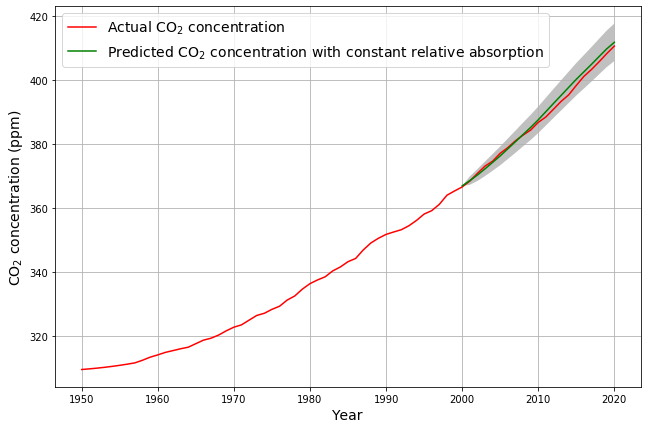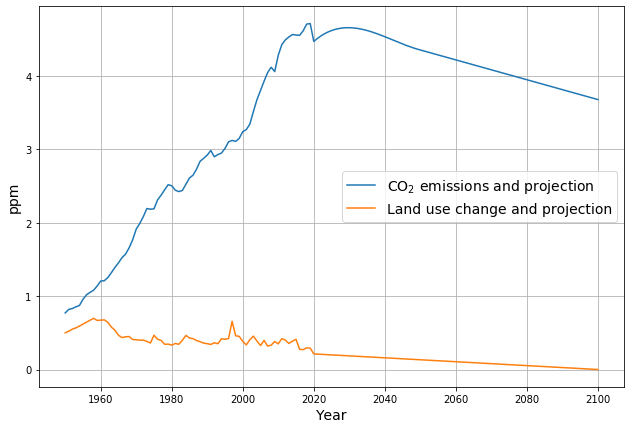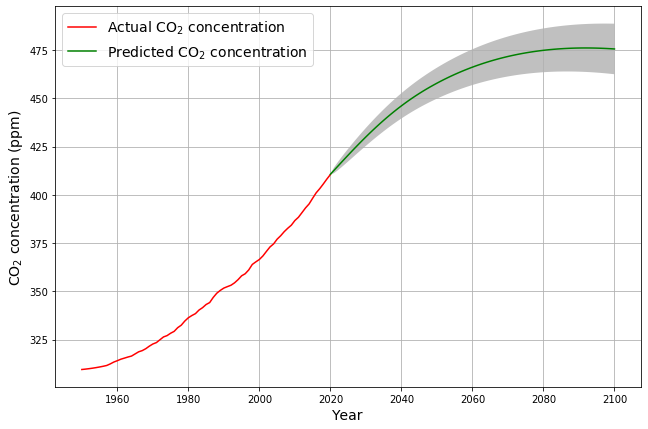Emissions and CO2 Concentration — An Evidence Based Approach
A New Way of Looking at the Problem
Climate science is usually concerned about the question „How much CO2 remains in the atmosphere?“, given the anthropogenic emissions and the limited capability of oceans and biosphere to absorb the surplus CO2 concentration. This has led to conclusions of the kind that a certain increasing part of anthropogenic
emissions will remain in the atmosphere forever. The frequently used notion of „airborne fraction“, which is the part of anthropogenic emissions remaining in the atmosphere, seems to suggest this.
We change the focus of attention by posing the logically equivalent question „How much CO2 does not remain in the atmosphere?”. Why is this so different? The amount of CO2 that does not remain in the atmosphere can be calculated from direct measurements. We do not have to discuss each absorption mechanism from the atmosphere into oceans or plants. From the known global concentration changes and the known global emissions, we have a good estimate of the sum of actual yearly absorptions. These are related to the CO2 concentration, motivating the guiding hypothesis for a linear model of absorption. It turns out that we do not need to know the actual coefficients of the individual absorption mechanisms—it is sufficient to assume their linear dependence on the current CO2 concentration.
This is a short summary of a recently published paper, where all statements expressed here are derived in detail and backed up with references and a mathematical model.
Mass Conservation of CO2
As in a bank account, the atmospheric CO2 balance results from total emissions reduced by total absorptions:
Concentration growth = Emissions – Absorptions
The total emissions (blue) come to exceed the yearly CO2 concentration growth (green), implying the growing effective absorption (red) with growing CO2 concentration:

The assumption of approximate linearity of the relevant absorption processes
This is visualized with a scatter plot, relating the effective CO2 absorption to the CO2 concentration.

We see a long term linear dependence of the effective absorption on the atmospheric CO2 concentration with significant short term deviations, where the effective zero-absorption line is crossed at appr. 280 ppm. This is considered to be the pre-industrial equilibrium CO2 concentration where natural yearly emissions are balanced by the yearly absorptions. The average yearly absorption is appr. 2% of the CO2 concentration exceeding 280 ppm. As the data before 1950 are subject to large uncertainty, the following calculations were done based on data after 1950, resulting in a slightly smaller absorption percentage of 1.6%.
CO2 concentration as a temperature proxy
When we make predictions with hypothetical future CO2 emissions, we do not know the future temperatures. Without diving into the problematic discussion about the degree, how strong the influence of CO2 concentration is on temperature , we assume the “worst case” of full predictability of temperature effects by CO2 concentration.

Without making any assumptions about C->T causality, the estimated functional dependence of the temperature proxy from the regression on CO2 concentration C was found to be: $$Tproxy = -16.0 + 2.77*log(C) = 2.77* log(C/(323ppm)) $$
This corresponds to a sensitivity of 1.92° C.
Model validation
The model with the assumption of constant absorption parameter and constant natural emissions is validated with a prediction of the CO2 concentratation 2000-2020 based on emission data 1950-2020 and Concentration data 1950-2000.

This is an excellent prediction of concentrations on the basis of emissions and the above model assumtions. There are only small apparently variations between the predictions and the actual data. Although the model allows for varying absorptions over time, the data of the last 70 years, which is the period of the bulk anthropogenic CO2 emissions, leads to the conclusion that the CO2 absorption parameter has no significant temperature or other time-dependent component, and a current CO2 emission pulse is absorbed with a 42 year half-life time.
Future Emission Scenario
The most likely future emission scenario is the IEA stated policies emission scenario of approximately constant, slightly decreasing global emissions. The actually used data set for a realistic future projection is created by trend extrapolating the stated policies beyond 2050 and assuming that the land use change data will follow the current trend and decrease to 0 by the year 2100 . Emissions will not be reduced to zero in the year 2100, but will remain close to the 2005 level.

Prediction of Future CO2 Concentration
From this realistic emission scenario the future CO2 concentration is recursively predicted with our model.
With the IEA stated policies scenario, i.e., no special CO2 reduction policies, a CO2 concentration equilibrium of approx. 475 ppm will be reached during the second half of this century.
Based on the empirical CO2 temperature proxy equation above, this increase of CO2 concentration from 410 ppm (in 2020) to 475 ppm corresponds to a temperature increase of 0.4° C from 2020, or 1.4°C from 1850.

Concluding, we can expect a maximum CO2 concentration level of approximately 475 ppm in the second half of this century. At this point, the emissions will be fully balanced by the absorptions, which is by definition the “net zero” situation.
Assuming the unlikely worst case that CO2 concentration is fully responsible for all global temperature changes, the maximum expected rise of global temperature caused by the expected CO2 concentration rise is 0.4° C from now or 1.4°C from the beginning of industrialisation.
Therefore, if we keep living our lives with the current CO2 emissions – and a 3%/decade efficiency improvement — , the Paris climate goals are fulfilled.